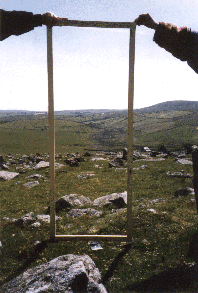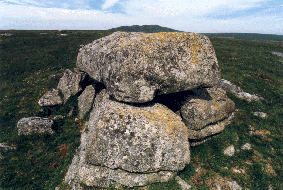 |
Doors of perception: the entrance, or threshold, of a house mediates and relates inside and outside, a social space of the interior with that of the exterior, private with public. It joins different worlds. The doorway orientations of the Leskernick houses are significant in that they link the house with the horizon rather than with the doorways of other houses or structures in the immediate vicinity. None of the houses have doorways which face or reach out to each other. The doorways all look out towards the distant tors and hills which enclose the settlement and shut it off from the rest of Bodmin Moor. The horizon line thus marks the boundary of the visual world of the Bronze Age populations (and ours). |
Doorway orientation was all about establishing ancestral connections and linking the domestic world of the settlement space with the cosmologies and myths associated with these distant rock outcrops and cairns. Their powers could be transferred to the house. Framing the external world the physical and cultural meanings of the entrances thus had a mythopoetic significance reproducing in a permanent form relations between the living, the ancestors and the spirit world in a perspectival 'movement' from house to cairn to rock. Doorway orientation alludes to the significance of the house as a whole as cosmological model of the world. The doorway acts a visual metaphor making concrete and serving to elucidate key aspects of cosmology and creation.
From the entrances of the houses facing south-west the skyline is dominated by a view towards Catshole and Tolborough Tors. The house entrances are directionally orientated towards the former, which when seen close-up, resembles a Neolithic quoit or burial chamber. This referencing of Catshole Tor thus has particular resonance in terms of ancestral associations and powers given that the Western settlement is earlier in date than the southern and possibly constructed during the later Neolithic.

Catshole Tor
With the exceptions of houses 28, and possibly 30, in the southern settlement the houses all look out to rounded hills, the Beacon and Brown Gelly, which do not have any tors but are surmounted by massive summit cairns which themselves resemble tors. 'Culture' thus resembles 'nature'. The cairns on Brown Gelly are well preserved and show up well on the photographs. On the Beacon the cairns have been largely destroyed for wall building in modern times.
Drawing horizon lines is a method we have adapted from the work of the environmental artist Hamish Fulton. It is an interesting way to represent place. From each house doorway the horizon line is unique. It is thus a representation of place emphazing relationality while neither depicting the place itself or its immediate context. Thus it is a kind of skeletal view of the world, laying bare its essentials. Comparing the horizon lines from the house entrances in the western and southern settlements shows a major contrast. Those from the southern settlement are much smoother, rounder and less distinctive in profile. The western settlement horizon lines are both more jagged and variable. The horizon here is both closer and much more dramatic. Most of the views from the houses in the southern settlement repeat each other with the entrances orientated towards Brown Gelly 7 km. distant.